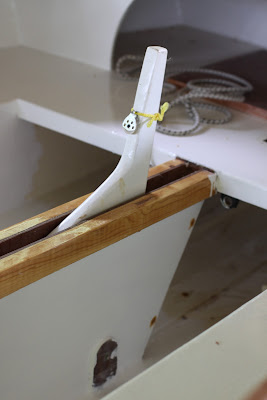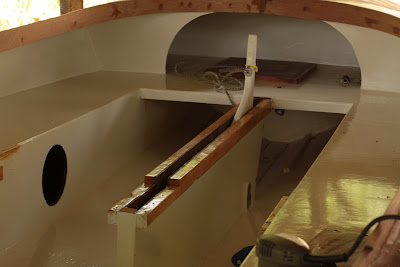Tuesday, September 25, 2012
Early Morning Cruise
Our nephew and his girlfriend were passing through town and made time to
spend a night and go for an early morning sail. Very nice visit. Great
to catch up.
Wednesday, September 19, 2012
Monday, September 3, 2012
Sunday, September 2, 2012
Saturday, September 1, 2012
Thursday, August 30, 2012
A few more pics
Wednesday, August 29, 2012
Prep for Launch
No pics to post today. I'm getting lots of little bits ironed-out in preparation for launching this Saturday. It's amazing how many little things accumulate toward the end of a project like this. Nevertheless, if all goes well, GoodFoot sails this weekend! So far I have had good luck uploading pics and video from my phone straight to the blog, so look for semi-live updates. I also, have the new GoPro camera so there should be some decent video posted late in the day.
Cheers
P
Cheers
P
Wednesday, August 8, 2012
It Floats!
Today was the day to register and title the boat, which required a trip to Garland about an hour away. So since I was in the neighborhood, my friend David invited me to stop by Rush Creek Yacht Club where we gave Goodfoot her first dunk. Without any crew weight or spars on board, she sat very high on her lines. In fact the chines were fully out of the water. Very encouraging.



Sunday, July 15, 2012
Tuesday, July 3, 2012
Tiller
I had considered either just buying a tiller from the infernal-marine-supply-store-not-to-be-named, but as expected, they wanted WAY too much $, or just using a stick of closet rod or something similar till I had more time to make something better. But I had some leftover mahogany from the material I bought for the rubrails, and figured anything other than a nice laminated tiller would annoy me until I did it right. So, here's the rough blank for a slightly curved, mahogany and fir tiller. Marie took the photos of the layup. She gets some nice shots, doesn't she.
 |
| Goopy, messy process. Laminating spars and the tiller is quickly decimating my remaining epoxy supply. Fortunately, there is not much left that calls for it. |
 |
Here it is
clamped in place after an initial clean up on the table saw. This photo was taken by me with my crappy phone
camera. I'll have Marie take nicer pictures once it is completely done.
Running rigging
I'm starting to add the running rigging. Here is the port turning block and cleat for the mizzen sheet. Both the mizzen and mainsheets are split and can be trimmed from either end. The mizzen runs to the either side of the aft deck near the transom and is split over the tiller to avoid interference. After it runs through a block there, it is led forward to the aft end of the cockpit and must be routed over the coaming. This mahogany block raises the block and cleat just high enough to give clearance.
Wednesday, June 27, 2012
Evening racing
Summer evening racing at Dallas Corinthian Yacht Club aboard "Scoots," a J 29 driven by Dan Wolf. This is a reverse-start race with faster boats starting behind.
Monday, June 25, 2012
Hatches with take-apart hinges.





Sunday, June 24, 2012
Wednesday, June 20, 2012
Sails by Sailrite
Thanks to Kevin and Joy for lending me their home including emptying out their living room for a couple days so we could spread out. Here is a small stop action of the process once we had most of the panels sewn together. This clip shows the joining of the last two sections of the main sail to form the final sail shape. The photos are from the GoPro Hero my lovely wife gave me for my birthday. If anyone out there knows of some good resources for learning to get good quality time lapse videos from GoPro files I would love some input.
There was still lots of work after this including hemming the leech, adding a bolt rope to the luff, and adding a tape to the foot. Still to come is adding all the grommets in the corners, sewing webbing loops for the sail slides, riveting the headboard in place, and various other little tasks. But for the most part, the sails are done!
I'll post more pics of some of the sail detail work soon.
Wednesday, June 6, 2012
Coamings and paint
Most of the work lately has been centered on getting the coaming finished. The coaming consists of two layers of bent plywood with exposed ply edges which are prone to water intrusion and not particularly attractive. So I added a thin mahogany cap to better seal the edges and hopefully give it a nicer, more finished look. Below, you can see a portion of the coaming with the cap epoxied in place.
This is a shot of the rough mahogany material and another after a quick sanding with 60 grit. Once it gets an epoxy coating, it will be quite a bit darker and redder like the adjacent deck.
The mahogany cap is cut a bit oversized and I will run the flush-cut router bit over it so it will match the thickness of the coaming exactly. The rear corners were a bit tricky and required a three-layer lamination to take the correct bend. So it's back to the bending jig to get those bits made.
I've also gotten a couple primer coats of white on the cockpit area. Once that has a chance to cure a bit, I will hit it with a couple coats of the off-white color I've chosen for the interior. Hopefully this will reduce glare a bit.
Here the centerboard is in place so I can start fitting the running rigging for the up/downhaul. I'm trying to route most of the rigging along side the centerboard case below the level of the seat tops so I can potentially add hatches to cover the foredeck to make a sleeping deck.
It's getting close to rigging time!
Thursday, May 24, 2012
decks and hatches
The mast steps are in place and the decks are on. I had been
debating whether to leave the decks natural or paint them. I’m going with the
paint. So the only natural wood showing will be the hatch covers, the cap for
the centerboard trunk, the thwart, the cockpit coaming and the rubrails.
The hatch frames are built and I am in the process of
building the hatch covers.
 |
The front hatch is significantly curved, so the hatch cover will be a bit tricky.
|
A friend took down an old pear tree and milled a few large
planks for me. I’m using these for the hatch cover frames and insetting the
marine ply.
Next up is epoxy coating the decks, sanding and painting the decks and the cockpit. I bought a HVLP sprayer for the painting, but it has been very windy for the past week and looks like it will be for the next several days. So I may just roll the paint on like I did with the hull.
Then I will bend the
coaming into place. The corners for this will require either steaming or
soaking in boiling water to make the wood pliable enough to take the bend. My
test run from a few weeks ago seemed to work fine as long as I stick with 6mm
plywood. Any thicker than that and no amount of steaming will allow it to bend
that much.
Subscribe to:
Comments (Atom)







































